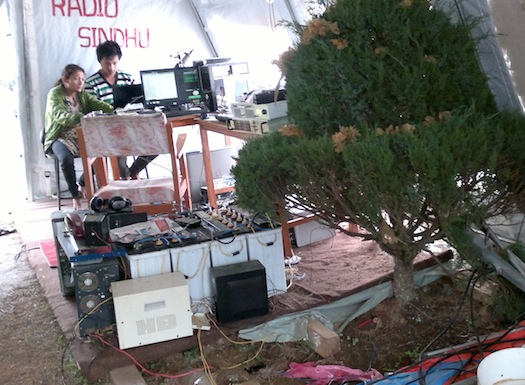After the disasterous earthquake in Nepal earlier this year, Community Radio stations mobilized to support people in their time of crisis.
In one example of the work of community stations, people were given water purifying tablets, but, as many were illiterate, they could not read the instructions and did not use them.
When local stations got back to air they began to broadcast segments to educate earthquake affected people how to purify drinking water in their temporary shelters.
They engaged children to help spread the message to their parents. Child led community journalism is a new practice of citizen journalism, using social and traditional media in Nepal.
In temporary shelters and affected villages child club and youth club members have become responsible to send feedback and information to the community radio stations. To assist in the recovery, if the problems are not solved at district level they are sent to the Community Information Network central broadcasting location, which follows up with ministers and other government officials.
The earthquake of Saturday, 25th of April 2015 affected more than 120 community radio stations, but most of them are now back on air, some from tents and some literally broadcasting from the field.
In spite of extremely challenging circumstances and amidst loss of infrastructures and equipment of the stations, community radios continue to serve local populations to ensure safety and security of lives and properties. To bring the situation back to normal, as well as caring for the emotional wellbeing of the survivors, the community radio sector’s umbrella body, ACORAB has been producing and broadcasting the radio programs called Jivan Raksha regularly. Also, in partnership with WVIN Community Information Network, they have been practicing community journalism in 6 districts. In total 66 community journalists have been interacting in community regarding the humanitarian issues.
The main goal of the community radio activity is “to empower earthquake survivors for effective use of the life skill in adverse situation so that the daily life can become easier,” through capacity building of journalists, public service announcements, radio programs and community journalism.
One of the big success stories of the community radio led recovery project is the case of water purification.
Aquatab is a water purification tablet that kills micro- organisms in water to prevent cholera, typhoid, dysentery and other water borne diseases. They are used for emergency water treatment in disaster situations and long term household water treatment.
Radio Sindhuli Gadhi made programs in partnership with ACORAB/CIN to educate survivors how to use these tablets.
From a makeshift station (pictured above), complete with a tree in the middle of the tent, the broadcasters educated the people about the problems of slow service delivery, damage to the drinking water supply and lack of pure drinking water in the earthquake affected area, and most importantly, how to use the tablets to make their water drinkable.

Without the information Aquatabs were totally useless, due to the lack of proper use. People just stored the tablets, some of them threw them away and most of them didn’t know what they were.
Community Journalists encouraged people to have conversation on children and health issues during the tea time and and they discussed the issue of Aquatabs.
The radio program on Aquatabs from Radio Sindhuli Gadhi became a big discussion point in the district and people soon learnt how to use the life saving tablets.
The pictures below show the devastation in the affected areas, which are still struggling today, so many months after the disaster.


